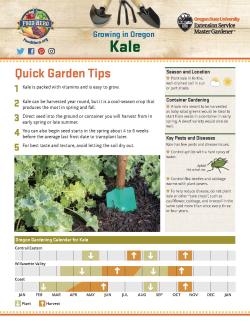Quick Garden Tips
- Kale is packed with vitamins and is easy to grow
- Kale can be harvested year round, but it is a cool-season crop that produces the most in spring and fall.
- Direct seed into the ground or container you will harvest from in early spring or late summer.
- You can also begin seed starts in the spring about 4 to 6 weeks before the average last frost date to transplant later.
- For best taste and texture, avoid letting the soil dry out.
Season and Location
- Plant kale in fertile, well-drained soil in sun or part shade.
Container Gardening
- A kale mix meant to be harvested as baby salad greens would be ideal to start from seeds in a container in early spring. A dwarf variety would also do well.
Key Pests and Diseases
- Control aphids with a hard spray of water.
- Control flea beetles and cabbage worms with plant covers.
- To help reduce disease, do not plant kale or other “cole crops”, such as cauliflower, cabbage, and broccoli in the same spot more than once every three or four years.
When to Plant and Harvest Kale in Oregon
- Central and Eastern: Plant mid-April through mid-May to harvest in July. Plant again in August to harvest in October.
- Willamette Valley: Plant March through mid-May to harvest mid-May through August. Plant again mid-July through mid-September to harvest mid-September through November.
- Coast: Plant February through mid-April to harvest mid-March through June. Plant again in August to harvest in October.

Recommended Types to Grow
- Kale can be smooth, bumpy, curly, or lacy and light green to deep purple.
- Varieties to consider: Dwarf Green, Curled Lacinato, Red Russian, Winterbor
When and How to Harvest
- Kale leaves can be eaten at any stage of growth.
- To extend the harvest, use the cut-andcome-again method, removing the outer leaves while they are still tender and no more than 8 inches long.
- To pick kale, clip or twist the base of the leaves close to the stalk. You can also harvest the entire plant by pulling it up by the roots. For best flavor, harvest in early morning or after a frost. Cold weather improves the flavor.
Storage and Cooking
- Refrigerate harvested kale in an open or perforated plastic bag for 5 to 7 days. Flavor becomes stronger and more bitter as kale is stored. You can eat kale raw or cooked.
- For raw salads, cut or strip away the thick stems. Chop the leaves and massage them to soften and reduce the bitterness.
- Blend fresh or frozen kale into smoothies and juices.
- Steam or sauté kale or mix chopped or torn leaves into sauces, soups, bean dishes and stir-fries.
- Try this Food Hero recipe: Crunchy Baked Kale Chips



